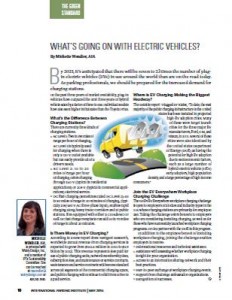By 2025, it’s anticipated that there will be seven to 23 times the number of plug-in electric vehicles (EVs) in use around the world than are on the road today. As parking professionals, we should be prepared for the increased demand for charging stations.
In the past three years of market availability, plug-in vehicles have outpaced the first three years of hybrid vehicle sales by a factor of three to one. Individual models have also seen higher initial sales than the Toyota Prius.
What’s the Difference Between Charging Stations?
There are currently three kinds of charging stations:
AC Level 1: Two to five miles of range per hour of charging,.AC Level 1 is typically used for charging when there is only a 120 V outlet available but can easily provide all of a driver’s needs.
AC Level 2: 10 to 20 miles of range per hour of charging, offers charging through 240 V (typical in residential applications) or 208 V (typical in commercial applications) electrical service.
DC Fast Charging (sometimes called DC Level 2): 60 to 80 miles of range in 20 minutes of charging, (typically 208/480 V AC three-phase input), enables rapid charging along heavy traffic corridors and at public stations. EVs equipped with either a CHAdeMO or SAE DC fast charge receptacle can add 50 to 70 miles of range in about 20 minutes.
Is There Money in EV Charging?
According to a new report from Navigant Research, worldwide annual revenue from charging services is expected to grow from $152.6 million in 2015 to $2.9 billion by 2023. This revenue represents fees paid for use of public charging units, network membership fees, subscription fees, and maintenance or service contracts. Maintenance and service contracts will become standard across all segments of the commercial charging space, and public charging will continue to shift from a free to a paid service.
Where is EV Charging Making the Biggest Headway?
The Deloitte report “Plugged In” states, “To date, the vast majority of the public charging infrastructure in the United States has been installed in projected high-EV adoption cities. Many of these were target launch cities for the three major EV manufacturers, Ford, GM, and Nissan, in 2011. Several of these cities were also identified by the United States Department of Energy (DOE) as having the potential for high EV adoption due to socioeconomic factors, such as a large number of hybrid-electric vehicle (HEV) early adopters, high population density, and a large percentage of high-income consumers.”
Join the EV Everywhere Workplace Charging Challenge
The DOE’s EV Everywhere Workplace Charging Challenge is open to employers of all sizes and industry types in the U.S. whose charging stations are primarily for employee use. Taking the challenge offers benefits to employers who are considering installing charging, as well as for those who have successfully launched workplace charging programs. IPI is a partner with the DOE in this program.
In addition to the employee benefit of installing workplace charging, joining the challenge enables employers to receive:
- Informational resources and technical assistance.
- Assistance with assessing whether workplace charging is right for your organization.
- Access to an information sharing network and their best practices.
- Peer-to-peer exchange at workplace charging events.
- Support from challenge ambassador organizations.
- Recognition of successes.
Michelle Wendler, AIA, is principal with Watry Design, Inc., and a member of IPI’s Sustainability Committee. She can be reached at mwendler@watrydesign.com or 408.392.7900.
TPP-2015-05-What’s Going On with Electric Vehicles

